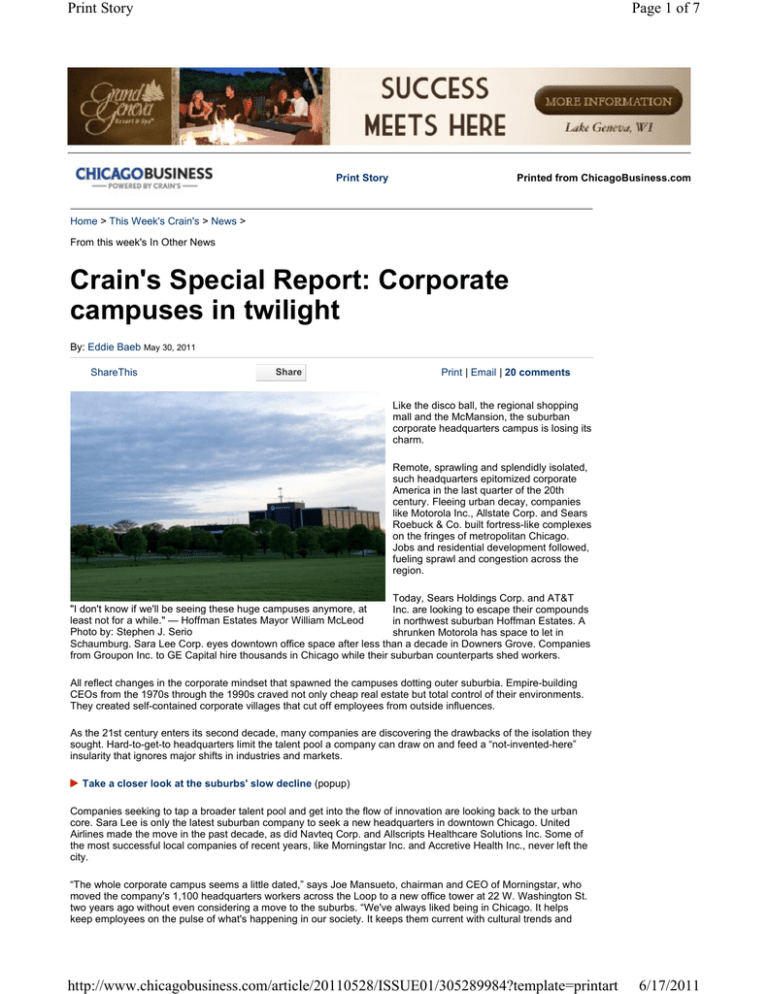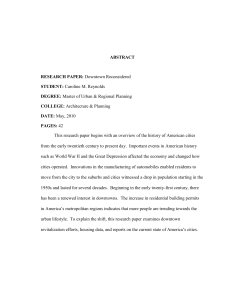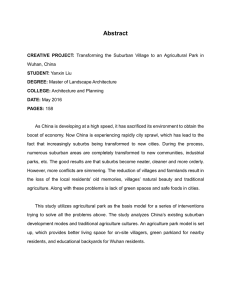Crain`s Special Report: Corporate campuses in twilight
advertisement

Print Story Page 1 of 7 Print Story Printed from ChicagoBusiness.com Home > This Week's Crain's > News > From this week's In Other News Crain's Special Report: Corporate campuses in twilight By: Eddie Baeb May 30, 2011 ShareThis Share Print | Email | 20 comments Like the disco ball, the regional shopping mall and the McMansion, the suburban corporate headquarters campus is losing its charm. Remote, sprawling and splendidly isolated, such headquarters epitomized corporate America in the last quarter of the 20th century. Fleeing urban decay, companies like Motorola Inc., Allstate Corp. and Sears Roebuck & Co. built fortress-like complexes on the fringes of metropolitan Chicago. Jobs and residential development followed, fueling sprawl and congestion across the region. Today, Sears Holdings Corp. and AT&T "I don't know if we'll be seeing these huge campuses anymore, at Inc. are looking to escape their compounds least not for a while." — Hoffman Estates Mayor William McLeod in northwest suburban Hoffman Estates. A Photo by: Stephen J. Serio shrunken Motorola has space to let in Schaumburg. Sara Lee Corp. eyes downtown office space after less than a decade in Downers Grove. Companies from Groupon Inc. to GE Capital hire thousands in Chicago while their suburban counterparts shed workers. All reflect changes in the corporate mindset that spawned the campuses dotting outer suburbia. Empire-building CEOs from the 1970s through the 1990s craved not only cheap real estate but total control of their environments. They created self-contained corporate villages that cut off employees from outside influences. As the 21st century enters its second decade, many companies are discovering the drawbacks of the isolation they sought. Hard-to-get-to headquarters limit the talent pool a company can draw on and feed a “not-invented-here” insularity that ignores major shifts in industries and markets. Take a closer look at the suburbs' slow decline (popup) Companies seeking to tap a broader talent pool and get into the flow of innovation are looking back to the urban core. Sara Lee is only the latest suburban company to seek a new headquarters in downtown Chicago. United Airlines made the move in the past decade, as did Navteq Corp. and Allscripts Healthcare Solutions Inc. Some of the most successful local companies of recent years, like Morningstar Inc. and Accretive Health Inc., never left the city. “The whole corporate campus seems a little dated,” says Joe Mansueto, chairman and CEO of Morningstar, who moved the company's 1,100 headquarters workers across the Loop to a new office tower at 22 W. Washington St. two years ago without even considering a move to the suburbs. “We've always liked being in Chicago. It helps keep employees on the pulse of what's happening in our society. It keeps them current with cultural trends and http://www.chicagobusiness.com/article/20110528/ISSUE01/305289984?template=printart 6/17/2011 Print Story Page 2 of 7 possibly technological ones.” The change has the same far-reaching implications for the region that the suburban stampede of the post-war era had on living and working patterns around Chicago. Well-paying jobs are up in the city, raising questions for the housing market in outer suburbia. New transit challenges will arise as more workers ditch suburb-to-suburb auto commuting and board trains and buses headed downtown. City officials must find ways to accommodate growth, while suburbs will have to grapple with the decline of the corporate estates they depend on for jobs and tax dollars. Suburban office landlords will struggle to fill cavernous vacancies at corporate campuses that are harder to rent out than city office towers. TOUGH TIMES AHEAD William McLeod, mayor of northwest suburban Hoffman Estates, finds himself at the center of a storm these days. The village's biggest private employer, Sears, is considering moving its 6,000-some-employee headquarters out of state, as the tax incentives that helped lure the retail giant from downtown in 1992 to develop the 786-acre Prairie Stone complex are set to expire next year. AT&T, the village's No. 2 employer, recently put its 1.5-million-square-foot campus (originally built in 1990 for Ameritech Corp.) up for sublease. The company says it intends to reduce its space in the complex or move the employees to other AT&T facilities in the area. “A community's not sustainable without business,” says Mr. McLeod, who's pushing for state legislation to extend Sears' tax breaks and hopes to lure smaller offices and manufacturing to the village, where about 200 acres around Sears' headquarters remain undeveloped. “I don't know if we'll be seeing these huge campuses anymore, at least not for a while.” Sears and AT&T, together, account for almost 30% of Hoffman Estates' private-sector jobs. Schools, parks and other agencies in the community rely on them for property tax revenue. Losing those jobs would hurt not only Hoffman Estates but towns to the north and west that saw tract housing spring up in the 1990s as more jobs came to the suburban fringe. ' The whole corporate campus seems a little dated.' — Joe Mansueto, chairman, Morningstar Inc. “I'm not going to use the word devastation, but it would be a big hurt to the northwest suburbs if they did leave,” says Tracy Cross, a housing industry consultant and head of Schaumburg-based Tracy Cross & Associates Inc. “If you take away 6,000 workers, the housing market would drop proportionately.” With job growth shifting to the city, homes on the exurban fringe become less attractive, says McKim Barnes, who heads research at Chicago real estate firm Draper & Kramer Inc. 'INSULAR MENTALITY' Long before Sears built its Hoffman Estates headquarters, the collar counties were growing fast, as private-sector employment almost tripled there over the 1970s and "80s, according to data from the Illinois Department of Employment Security and Draper & Kramer. Motorola brought its headquarters to northwest suburban Schaumburg in 1976. The then-remote location reflected the company's aloof style, based on engineering prowess that produced the first cellular telephone. But after dominating the industry in the early 1990s, Motorola was slower than competitors like Cupertino, Calif.-based Apple Inc. to see the potential in digital technologies that gave rise to the smartphone. “They are an example of a company that thought they could do it all because they hired really smart people,” says Thomas Kuczmarski, president of Kuczmarski & Associates Inc., a Chicago-based management consulting firm. “They probably needed to be more focused on where the consumer was going.” Sanjay Jha, CEO of one of the two companies Motorola was split into earlier this year, has acknowledged as much. His company, the cellular phone business Motorola Mobility Inc., will keep its headquarters in Libertyville but is hiring hundreds in Sunnyvale, Calif., near Google Inc.'s headquarters. Motorola Solutions Inc., which makes communications systems for police and fire departments, and bar-code scanners for a number of applications, is staying in Schaumburg. But it doesn't need the whole campus perched on 316 verdant acres alongside the Jane Addams Memorial Tollway. http://www.chicagobusiness.com/article/20110528/ISSUE01/305289984?template=printart 6/17/2011 Print Story Page 3 of 7 The company employs fewer than 4,500 in Schaumburg, down from about 7,000 during Motorola's heyday. Recently the company put two buildings totaling 430,000 square feet up for lease. Another trend working against the traditional corporate campus is the decentralization of many companies that once concentrated large numbers of workers at a single location. Like Motorola Mobility, global firms are spreading employees around the country and even the world as they try to get closer to far-flung markets and tap into clusters of skilled workers. That makes it tougher for suburbs like Hoffman Estates to find new occupants for sprawling headquarters complexes built to the specifications of a single company. “It's going to be extremely difficult,” says William Elwood, executive vice-president with CB Richard Ellis Inc. who represents suburban office landlords. “It could, in many cases, take years to re-tenant some of these.” URBAN OPERATING BASE Some companies that retain suburban headquarters establish downtown outposts to draw skilled younger workers, many of whom prefer to live and work in the city. Motorola opened a design center in 2003, in part to “attract hip, young designers,” a Motorola Mobility spokeswoman says. Likewise, drugstore giant Walgreen Co. has an office for its new e-commerce division downtown rather than at its Deerfield campus. Last week, finance giant GE Capital announced plans to add 1,000 employees downtown in the next several years, almost doubling its workforce here, with some of those jobs coming from suburban offices. Chicago “offers a deep pool of financial services talent we can draw upon,” GE Capital Americas President and CEO Dan Henson says in a statement. Other executives say central city locations help recruiting efforts not only with young, urban professionals but also with workers throughout the region. For most people in greater Chicago, it's easier to commute downtown than to a suburb on the other side of the metropolitan area. “Some people turned us down for jobs because they didn't want to make that commute every day,” says Lance Chambers, CEO of Bel Brands USA, the subsidiary of a French cheesemaker that in March moved its 80-person office to Wacker Drive from Elk Grove Village. “It gives us a much bigger talent pool to pull from. And there's just this energy in the city.” One of the biggest local companies to go public in recent years, hospital revenue consulting firm Accretive Health Inc., last year won a tax-increment financing subsidy and state incentives to build a processing and training operation at 231 S. LaSalle St. after considering sites in Albuquerque, N.M., Jacksonville, Fla., and Nashville, Tenn., according to the planning department's staff report. Accretive pledged to hire 650 people for the facility over 10 years, in addition to maintaining a headquarters staff of 175 on North Michigan Avenue. Sara Lee, which moved its headquarters to Downers Grove from Madison and Dearborn streets just six years ago, is considering a return. The foodmaker is shedding several divisions to focus on its North American meats business, which is scouting for about 150,000 square feet downtown, real estate sources say. A Sara Lee spokesman says the company is “evaluating all options pertaining to our corporate headquarters location” and “no decision has been made to move.” RE-TRAINING If growing firms continue to opt for city locations, transportation planners need to focus less on suburban highways and more on getting people into and around an expanding central city business district. “Your transportation investments ought to be driven by your desire to grow the economy, not to spread investment across the state as if it were peanut butter, which is what we do now,” says Frank Beal, executive director of Chicago-based Metropolis Strategies, a regional economic development group. “The global economy is changing in ways that demand higher densities that can only be serviced with transit.” Former United Airlines chief Glenn Tilton said access to transit was key in the company's decision to leave its 1million-square-foot campus in Elk Grove Township, which dates to 1961, and move its main operations facility and more than 2,500 workers to the former Sears Tower. United had moved its 350 headquarters staffers to 77 W. Wacker Drive in 2007. http://www.chicagobusiness.com/article/20110528/ISSUE01/305289984?template=printart 6/17/2011 Print Story Page 4 of 7 At a press conference in August 2009 in the Willis Tower lobby, Mr. Tilton said 80% of the company's employees live within five miles of a Metra station. “All things considered, this facility, both from an economic perspective and a quality of work-life perspective, was the best facility in the running,” Mr. Tilton said. SIDEBAR For big pharma, Lake County is the place to be While more companies are shunning suburban bases in favor of the deeper talent pool and opportunities for collaboration downtown, pharmaceutical firms are finding many of the same benefits along the Tri-State Tollway in Lake County. The area has become a hub for the industry, with a critical mass of talent and companies that encourages the innovation and cross-pollination that often goes missing in the corporate campus setting. There are 49 pharmaceutical-related companies in Lake County with a total of more than 18,000 employees, or about 7% of all the private-sector jobs in the county, according to Lake County Partners, the county's private-public economic development arm. Anchoring the corridor are the massive headquarters complexes of three of the area's biggest companies: Baxter International Inc. and Walgreen Co. in Deerfield, and Abbott Laboratories in North Chicago. Their presence helped attract others, such as Hospira Inc. and Akorn Inc., both in Lake Forest, along with the U.S. arms of Takeda Pharmaceutical Co. Ltd. and Astellas Pharma Inc., the largest and second-largest Japanese drugmakers, respectively. Hospira was spun off by Abbott in 2004. Takeda's ties to the area date to 1977, when it formed a joint venture with Abbott that dissolved in 2008. It built its headquarters in Deerfield in 2006. Astellas is building a 425,000-square-foot campus in Glenview at the former home of water treatment company Culligan International Co., at Interstate 294 and Willow Road. Some 1,000 employees will work in Astellas' glass-clad, six-story building when the company moves there next spring from a Deerfield office park. The new site was chosen for its convenience to Astellas' current employees, to raise the visibility of the company and to help with recruitment, says Collette Taylor, a senior vice-president who is leading the move. "Out here in the northern suburbs there's a wealth of talent to draw from, either from other pharmaceutical companies or elsewhere," Ms. Taylor says. "People like the access to downtown, they like that it's a very easy place to get around, with great schools and great universities." Eddie Baeb © 2011 by Crain Communications Inc. ShareThis Share Print | Email | Comments What do you think? Rob B. wrote: At Belles Architecture, in the "western suburb" of Rockford IL, we have another take on the decline of the corporate campus. The internet has SIGNIFICANTLY changed the way business works - our office included. No longer are people tied to a desk in a cube farm. Most of the product reps that call on our office work out of http://www.chicagobusiness.com/article/20110528/ISSUE01/305289984?template=printart 6/17/2011 Print Story Page 5 of 7 their house and car. The old phone and desk at the corporate campus are unnecessary. Even in our small practice we have found a lap-top with internet allows an architect to work as effectively in Rome, Santiago, or Chicago. We can even go to the owner's existing building as set up a small work area and accomplish more in one day on-site than three days measuring, driving, drafting, etc..... Belles Architecture predicts an exodus of people from the City to places, like Rockford, where you can purchase more house for less money while the corporate campus is downsized to nothing but meeting rooms. Perhaps, some day, the corporate campus will be nothing but computers and the people who keep them running. http://www.bellesarchitecture.com 6/6/2011 6:58 PM CDT Recommend (1) Report Abuse Permalink Mckim B. wrote: This is a letter I submitted to the Crain's editors regarding the above article. They declined to publish it. I trust they'll print it here. I would like to clarify a quote attributed to me in the "Campus Twilight" article. Your reporter asked me the likely effect on housing demand of a major move of jobs from the suburbs to the areas closer to or in the central city. The proposed situation was very hypothetical. It is not happening now, nor, in my view, is it likely to. I refer your readers to data readily available from the Where Workers Work (WWW) internet site maintained by the Illinois Department of Employment Security (everyone should be aware of and use this site). With the exception of the explosive job growth in the far suburbs from 1982 to the year 2000, the tables in WWW indicate a moderately growing share of jobs in the far suburbs since 2000 and a moderately declining shere in the part of the city located outside the downtown and in the "inner suburbs." The downtown share has remained almost exactly the same -- between 13.6% and 13.8% -- for many years. The Census data now being released for 2010 portray an overwhelming "vote" for a residence in the "far collar counties" – that is, counties other than Cook and DuPage. The number of occupied housing units, or "households," increased by about 180,000 in the 10-County Chicago region (including Kenosha County, Wisconsin) from the year 2000 to 2010. Over 176,000 households took up residence in the far collar counties. In other words, the increase in households in the far collar county suburbs accounted for 98% of the total increase in the entire region. The city of Chicago lost about 16,500 households. If you exclude from the tally the city's five affluent Community Areas that extend from Lakeview south to the Near South Side, the remaining city neighborhoods lost nearly 32,000 households. This is hardly a mass migration from the far suburbs to the dense core. McKim N. Barnes Sr. VP Research Draper and Kramer, Incorporated 6/6/2011 4:33 PM CDT Recommend Report Abuse Permalink D L. wrote: OMG - Did the City of Chicago pay for this article? 6/2/2011 10:04 AM CDT Recommend Report Abuse Permalink Joseph T. wrote: Don't toss out suburban living yet. Any rational person who wants to raise kids (the hip youngsters will get older) is certainly not going to send them to the Chicago Public Schools--unless they can squeeze into the few slots at a magnet school OR pay big $$$ at a private school. Toss in crime, a corrupt Chicago city gov't, a structural budget deficit every year as far as the eye can see, and you can see many people don't want to live in Chicago . As for the commute, how many want to be tethered to a non rush hour Metra schedule when they want to leave work early or later than normal? I'm sure Tilton of UAL didn't ask his employees about that. As the Lake County Pharma sidebar shows, there is still a big labor force available to work at their facilities.. 6/1/2011 7:48 PM CDT Recommend (1) Report Abuse Permalink chet e. wrote: http://www.chicagobusiness.com/article/20110528/ISSUE01/305289984?template=printart 6/17/2011 Print Story Page 6 of 7 What a bunch of pathetic under achieving LOSERS!!! OMGAWD -- have you ever been to 1 Infinite Loop in Cupertino ? Well friends, guess what, it ain't a shimmering tower linked with rapid transit. Apple's CORPORATE HQ CAMPUS is pretty much THE SAME as Motorala's spread. The "googleplex" at 1600 Amphitheatre Parkway in Mountainview CA? No towers there either. How much the BIGGEST retailer in the country, surely Sears would love to tap into that "pool of talent" -- oh, WalMart's HQ is at 702 SW 8th St, a big old office park in BENTONVILLE AR... Heck even Nordstrom's is hardly in a "tower" -- 1617 6th Ave, Seattle WA has more in common with the old Marshall Field flagship on State St than anything along Wacker Dr or other rows of modern steel & glass sky scrapers. How can the quick service restaurant giant, McDonalds survive on its arborteum-like campus in Oak Brook? Well maybe talented people see the value of living in an area where their kids go to some of highest performing public schools in the state, where safety is a non-issue and low property taxes are cherished for all instead of ridiculous burden shifting hitting businesses harder than residential development to "buy off the silence" of Union workers forced to live inside Chicago's boundaries... When firms UNDERPREFORM their competitors it is ALL TOO EASY to look at irrrevelant issues and blame those things on their failures. Sara Lee's real growth phase when it was the KING of frozen bakery and HQ was in Northbrook. The acquisition-made finance lunatics that ran the place with a playbook borrowed from Enron are responsible for its crushing debt load, and any move that allows them to shed bloated staff and extract financial concessions from some desperate municipaliltiy / state will help their short term accounting, but ultimately leave them a shadow of their once enviable position. More than a little ironic that the Downers Grove site they now inhabit was built by the expansion minded dodos that ran Spiegal to the summit than sold them to gullible Germans - no mention of how "not invented here" was part of their "ruin" -- quite the opposite if they were still headquartered in Bridgeport they'd probably be little more than a footnote under "places to buy dowdy housecoats"... No doubt "star architects" would LOVE to pretend that shiny new buildings change the mindset of firms / organization, but whether one is thinking of Helmut Jahn's State of Illinois Building (ok Thompson Center...) or Rehm Koolhaus' additions to the IIT campus, or even Gehry's Millenium Park extravaganza the fact Rod was just as corrupt in his office as Otto Kerner was in the old place, IIT still is way down the list of choices for both talented students and faculty when they see how isolated and barren the place is, and a veritable army of quasi-security forces are needed to keep vandals from stripping every bit of "scrap metal" from Cloudgate clear through the bandshell... 6/1/2011 4:15 PM CDT Recommend (8) Report Abuse Permalink Jennifer B. wrote: Motorola and Sears clearly did themselves harm, perhaps irreparable, when they relocated to isolated campuses. It just took years for the results to materialize. Personally, I would relocate to another city rather than take a job in the suburbs. Chicago is a tremendous city (the best!) with so much going for it that I can tolerate the weather but if I had to spend all my time in the suburbs I might as well be in some non-descript Sunbelt metro with warmer weather. Avid sports fans and those with family in the area would strongly disagree I'm sure. 6/1/2011 12:43 PM CDT Recommend (4) Report Abuse Permalink Dave B. wrote: About 15-20 years ago, I read an article in the WSJ (I believe) stating that whenever a company moved its headquarters, 90% of the time it moved closer to the CEO's home. The decision was likely made for his convenience, or at least with a bias toward what he thought was good for people. There was little regard for the huge disruption to his workforce or the eventual limit it would place on the availability of talent. 5/31/2011 11:09 PM CDT Recommend (7) Report Abuse Permalink Aqua V. wrote: http://www.chicagobusiness.com/article/20110528/ISSUE01/305289984?template=printart 6/17/2011 Print Story Page 7 of 7 B.D. Chicago doesn't have its own income tax either, so how is your comment relevant? Seth B and David S. A Clinton Street Subway would open up the West Loop employment centers to easier access from btoh the North and South sides. A Lawrence Subway connecting Red to Blue would connect jobs near O'Hare with residents all across the north side, and bolster the case for a Cicero elevated line. Those would be projects that would greatly enhance employment access to and from the city. 5/31/2011 4:16 PM CDT Recommend (2) Report Abuse Permalink John C. wrote: ANd yet a lot of companies are still moving to these .. particularly in Texas. The price of gas and traffic congestion are main drivers of this movement on the positive side. The negative side: crime, corruption, and HIGH TAXES in Chicago! 5/31/2011 3:43 PM CDT Recommend (3) Report Abuse Permalink Robert O. wrote: Great article! Suburbs are isolated, sprawl without culture and they kill the environment. They are isolated from mass transit and not walkable. Let's keep the jobs moving into the city! Suburbs are vast wastelands of subsidized sprawl with no soul or sense of place. They lack significant architecture and design and people are isolated in their cars driving everywhere. This article is very encouraging! Suburbs are bad for business as people waste so much valuable, productive time driving. 5/31/2011 3:08 PM CDT Recommend (13) Report Abuse Permalink 1 2 >> Last (Note: Your first name and last initial will appear with your remarks.) Advertisement http://www.chicagobusiness.com/article/20110528/ISSUE01/305289984?template=printart 6/17/2011





